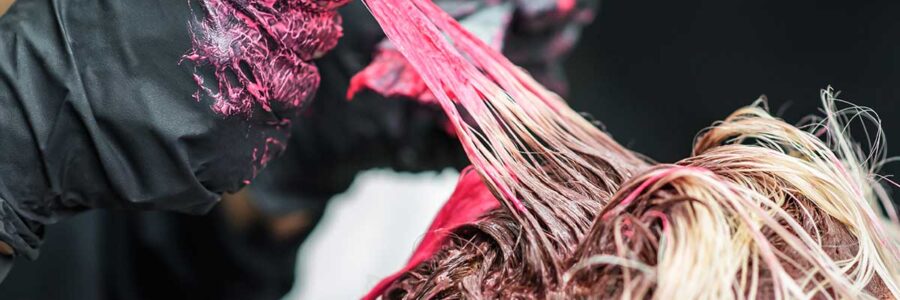Changing one’s hair color has become a popular way for many to express themselves or to hide gray hair. This transformation, achieved through various vibrant shades and techniques, can significantly boost confidence and refresh one’s appearance. However, the process is not without risks, largely due to the toxic chemicals often found in hair dye products. This blog explores the chemical components involved in hair dyeing and their potential health effects, providing valuable insights for those considering their hair dye options.
The Chemistry of Hair Dye: What Are You Applying to Your Scalp?
Applying hair dye is not just a cosmetic change but a complex chemical process that takes place right on your scalp. The typical ingredients list on hair dye packages resembles a chemistry set, including parabens, bisphenols, phthalates, lead acetate, resorcinol, formaldehyde, and various fragrances.[1] These substances help preserve the dye’s longevity and enhance color penetration into the hair shaft. Despite their functional benefits, the use of these chemicals is concerning, as many are known as hormone disruptors, and some are linked to an increased risk of cancer.[1]
From Vanity to Health Concern: The Side Effects of Hair Dye
While achieving the perfect hair color can be fulfilling, it can also introduce a host of health issues, from mild irritations to more serious, long-term conditions.[1] The hormone-disrupting chemicals found in many hair dyes can lead to hormonal imbalances, manifesting as unexplained weight gain, mood swings, or disrupted menstrual cycles.[2] Additionally, dermatological reactions are common, with symptoms like itching, redness, and rashes frequently reported.
More alarmingly, certain chemicals in hair dyes have been associated with an increased risk of various cancers, including those of the breast, bladder, and bones.[3] The potential for prenatal complications also suggests that pregnant women should exercise caution.[4] Moreover, the weakening of hair and subsequent hair loss is another concern that moves the use of hair dye from a cosmetic to a health concern.
Making Informed Choices: Navigating the World of Hair Dye
Given these risks, making informed choices about hair dye products is increasingly important. Before choosing a dye, thorough research into its ingredients and the potential health impacts is crucial. Learning to read and understand product labels and seeking out natural or less harmful alternatives can greatly diminish the risk of adverse reactions. While no hair dye product is entirely risk-free, selecting those free from known carcinogens and allergens can help mitigate potential health issues. Consulting with hair care professionals about safer dyeing practices and products can also be beneficial.
Alternatives to Traditional Hair Dyes
There are several safer alternatives to traditional hair dyes for those looking to avoid these risks. Natural dyes and henna are excellent options, deriving their coloring properties from plants and minerals rather than synthetic chemicals. These alternatives are less likely to cause adverse reactions and offer additional benefits, such as conditioning and strengthening the hair. While the color range may be more limited, the resulting shades are vibrant and can provide a unique aesthetic appeal.
Embracing Your Natural Hair Color
Alternatively, embracing your natural hair color is a healthy option that celebrates the beauty of authenticity. For those not ready to go fully natural, treatments that enhance the hair’s natural highlights or improve its condition, like glossing treatments or natural oil masks, can be appealing. These methods allow for beauty enhancement without the risks associated with synthetic dyes.
Summary
Choosing to dye your hair is a personal decision influenced by many factors, including style preferences and cultural influences. However, understanding the potential health implications is critical. You can align your beauty routines with your health needs by being informed about the risks associated with traditional hair dyes and considering safer alternatives. Remember, true beauty should never compromise well-being.
References:
- He, Lin et al. “Hair Dye Ingredients and Potential Health Risks from Exposure to Hair Dyeing.” Chemical research in toxicology vol. 35,6 (2022): 901-915. doi:10.1021/acs.chemrestox.1c00427
- Cleveland Clinic Medical. “Hormonal Imbalance: Causes, Symptoms & Treatment.” Cleveland Clinic, my.clevelandclinic.org/health/diseases/22673-hormonal-imbalance. Accessed 26 Mar. 2024.
- “Hair Products and Cancer Risk.” National Cancer Institute,www.cancer.gov/about-cancer/causes-prevention/risk/substances/hair-dyes-fact-sheet. Accessed 26 Mar. 2024.
- Ooka, Tadao et al. “Association between Maternal Exposure to Chemicals during Pregnancy and the Risk of Foetal Death: The Japan Environment and Children’s Study.” International journal of environmental research and public health vol. 18,22 11748. 9


